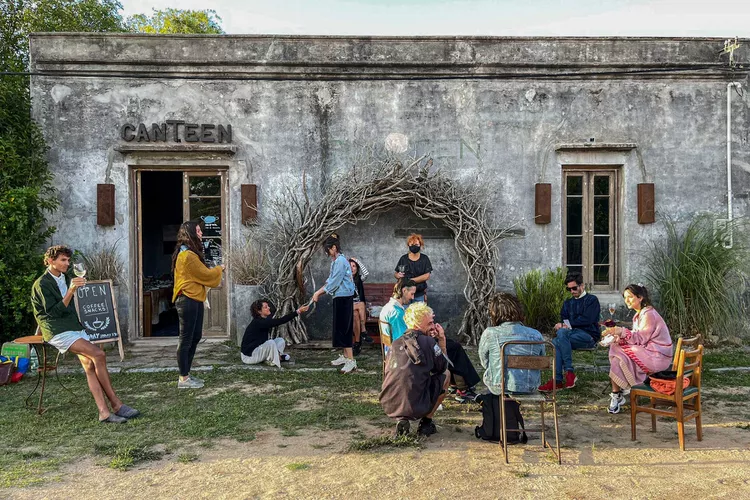1. Overview
Creative institutions are transforming the rural towns of Uruguay into vibrant cultural hubs along the sun-kissed coastline.
2. The Skyspace Experience
Insects hummed and frogs croaked as I sat on a granite bench inside a small, dome-roofed structure in the Uruguayan beach town of José Ignacio. It was a muggy day in late January, and my partner, Felipe, and I were staring at the tangerine sunset through a hole in the snow-white marble ceiling of Ta Khut, South America’s first freestanding Skyspace installation by American artist James Turrell. Artificial light in the structure’s interior fluctuates with the natural fade of dawn and dusk, lulling visitors into an almost meditative state of mind.
Thirty or so of us had gathered that evening, and all were transfixed by the changing shades — dandelion and violet one minute, black and lavender the next. Soft flashes of heat lightning crackled through the open roof as the world outside became darker and the Skyspace glowed ever brighter. After 40 minutes, we emerged from our colorful cocoon into the inky night in a complete daze. The other artworks scattered around our 17-room hotel, Posada Ayana, would have to wait until tomorrow.
3. Discovering José Ignacio
Convincing Felipe to visit Uruguay’s Atlantic coast for a culture-fueled long weekend had been challenging. As the deputy director of an art museum in Santiago, Chile, he associated the region primarily with Punta del Este — a flashy hub filled with celebrity sightings. However, as we explored the area, he began to see its artistic merit.
:max_bytes(150000):strip_icc():format(webp)/TAL-faara-art-center-URUGUAYART1022-85c0c2291242446d9c8063387e98ea07.jpg)
During our lunch in La Barra, a laid-back resort about six miles east of Punta, we dined at Café El Tesoro. We enjoyed globally inspired dishes, such as tuna tartare with turmeric tostadas and a rich burrata salad with pistachio pesto, surrounded by an eclectic array of art books and ceramics. That evening, after our time in the Skyspace, we agreed that while Punta del Este may have its reputation, the coastal towns to the east are establishing a dynamic, international creative scene.
4. José Ignacio’s Evolution
The former fishing village of José Ignacio has become a trendy beachfront enclave filled with galleries, boutiques, and notable architecture. Here, art spaces have emerged, including the new ceramics studio of Argentine sculptor Marcela Jacob, along with unique boutiques and statement buildings like Edgardo Giménez’s Casa Neptuna.
Although it is often dubbed the Hamptons of South America, its atmosphere is delightfully playful. Resident Francis Mallmann, an influential chef, played a pivotal role in shaping the area’s cultural landscape when he opened Posada del Mar in 1978. In 2020, he returned to introduce Chiringuito Francis Mallmann, a beachside restaurant that embodies casual elegance.
:max_bytes(150000):strip_icc():format(webp)/TAL-francis-mallmann-chiringuito-URUGUAYART1022-28496ae1661745dfb683c1f87d6b0f98.jpg)
5. Exploring Pueblo Garzón
The next day, we ventured to Luz Culinary Wine Lodge, a minimalist six-suite hotel on a stunning estate. This location serves as a convenient base for exploring Pueblo Garzón, an under-the-radar destination reminiscent of Marfa, Texas.
Despite its decline after the closure of the railway in the 1960s, Pueblo Garzón has maintained its charm, attracting artists who have transformed abandoned homes into galleries. American photographer Heidi Lender, who founded the creative institute Campo there in 2017, praises the unique landscape’s suitability for artistic endeavors.
:max_bytes(150000):strip_icc():format(webp)/TAL-atchugarry-art-museum-URUGUAYART1022-16ce9c071a5b400ea8bc97c6400461ea.jpg)
6. The Art Scene and Museums
During our exploration, we discovered two galleries, Walden Naturae and La Galerilla, which display significant contemporary artworks while celebrating the region’s artistic heritage. Furthermore, we visited the Museo de Arte Contemporáneo Atchugarry, a milestone for Uruguay’s contemporary art movement, located in a breathtaking 99-acre sculpture park.
The museum showcases works from Uruguayan and international artists, helping solidify the region’s status as a premier art destination. It aims to reveal the heart of culture within this coastal paradise, attracting visitors not only for its beautiful beaches but also for its rich artistic offerings.




